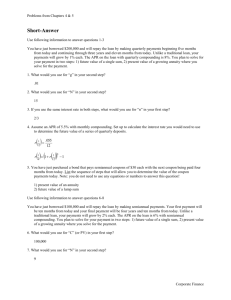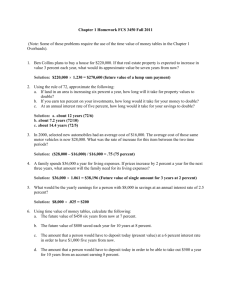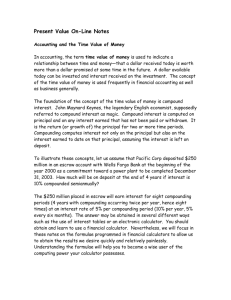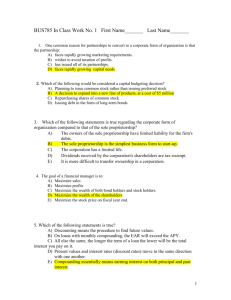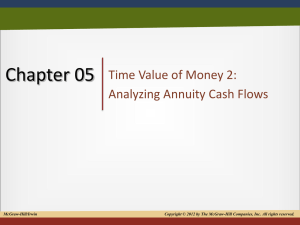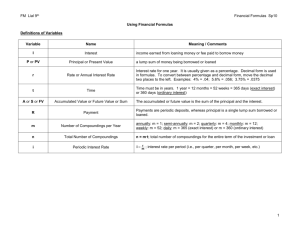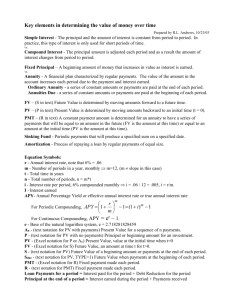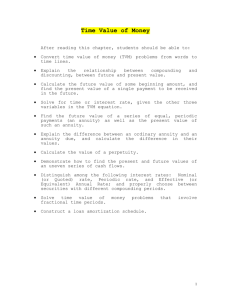Note: For any question with numbers, all of the points are earned by
advertisement
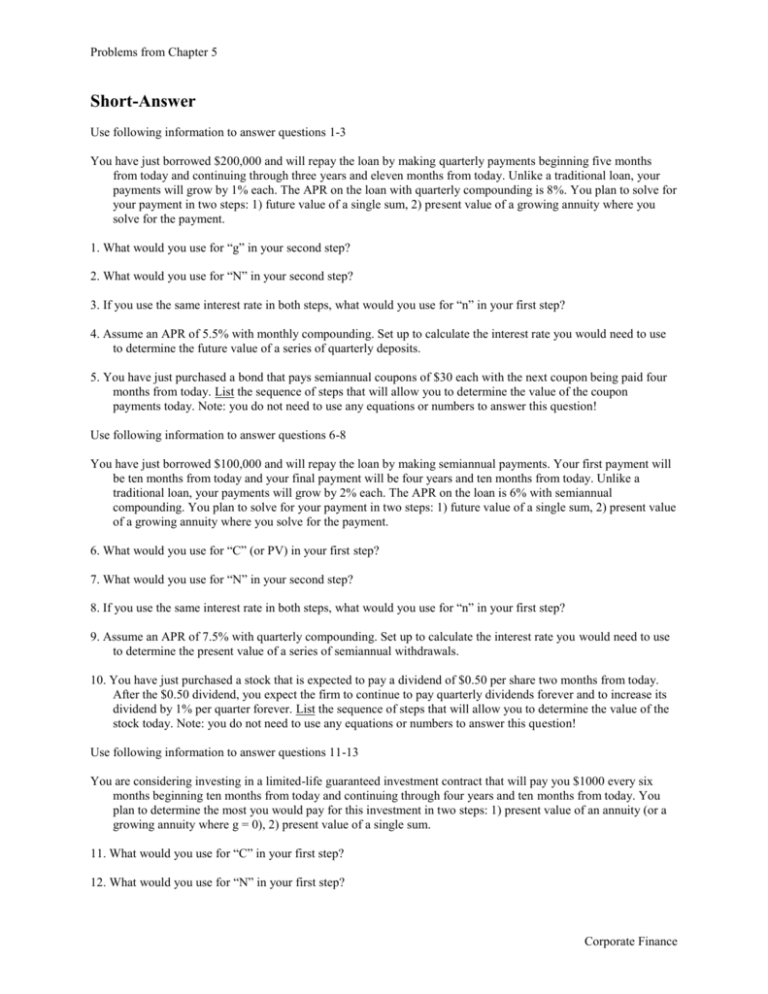
Problems from Chapter 5 Short-Answer Use following information to answer questions 1-3 You have just borrowed $200,000 and will repay the loan by making quarterly payments beginning five months from today and continuing through three years and eleven months from today. Unlike a traditional loan, your payments will grow by 1% each. The APR on the loan with quarterly compounding is 8%. You plan to solve for your payment in two steps: 1) future value of a single sum, 2) present value of a growing annuity where you solve for the payment. 1. What would you use for “g” in your second step? 2. What would you use for “N” in your second step? 3. If you use the same interest rate in both steps, what would you use for “n” in your first step? 4. Assume an APR of 5.5% with monthly compounding. Set up to calculate the interest rate you would need to use to determine the future value of a series of quarterly deposits. 5. You have just purchased a bond that pays semiannual coupons of $30 each with the next coupon being paid four months from today. List the sequence of steps that will allow you to determine the value of the coupon payments today. Note: you do not need to use any equations or numbers to answer this question! Use following information to answer questions 6-8 You have just borrowed $100,000 and will repay the loan by making semiannual payments. Your first payment will be ten months from today and your final payment will be four years and ten months from today. Unlike a traditional loan, your payments will grow by 2% each. The APR on the loan is 6% with semiannual compounding. You plan to solve for your payment in two steps: 1) future value of a single sum, 2) present value of a growing annuity where you solve for the payment. 6. What would you use for “C” (or PV) in your first step? 7. What would you use for “N” in your second step? 8. If you use the same interest rate in both steps, what would you use for “n” in your first step? 9. Assume an APR of 7.5% with quarterly compounding. Set up to calculate the interest rate you would need to use to determine the present value of a series of semiannual withdrawals. 10. You have just purchased a stock that is expected to pay a dividend of $0.50 per share two months from today. After the $0.50 dividend, you expect the firm to continue to pay quarterly dividends forever and to increase its dividend by 1% per quarter forever. List the sequence of steps that will allow you to determine the value of the stock today. Note: you do not need to use any equations or numbers to answer this question! Use following information to answer questions 11-13 You are considering investing in a limited-life guaranteed investment contract that will pay you $1000 every six months beginning ten months from today and continuing through four years and ten months from today. You plan to determine the most you would pay for this investment in two steps: 1) present value of an annuity (or a growing annuity where g = 0), 2) present value of a single sum. 11. What would you use for “C” in your first step? 12. What would you use for “N” in your first step? Corporate Finance Problems from Chapter 5 13. If you use the same interest rate in step 2) that you did in step 1, what would you use for “n” in your second step? 14. Assume an APR of 8% with quarterly compounding. Set up to calculate the equivalent interest rate you would need to use to determine the present value of a series of monthly deposits. 15. You have just invested $1000 in a security that will make quarterly payments to you. The first payment will occur nine months from today, the last payment will occur five years from today, and each subsequent payment will grow by 1% each. List the sequence of steps you that would allow you to determine the size of the first and fourth payments you can expect to receive. If you are not solving for the “name” of the step (such as the present value of a single sum), state what you are solving for (such as payment or interest rate or number of payments). Assume you have an interest rate that you can use to calculate present or future values. Note: you do not need to use any equations or numbers to answer this question! Use following information to answer questions 16 – 18 You are considering investing enough in an amortized CD at your bank that the CD will pay you $100 every six months beginning seven months from today and continuing through four years and one month from today. You plan to determine how much you will need to invest in two steps: 1) present value of an annuity (or a growing annuity where g = 0), 2) present value of a single sum. 16. What would you use for “C” in your first step? 17. What would you use for “N” in your first step? 18. If you use the same interest rate in step 2) that you did in step 1, what would you use for “n” in your second step? 19. Assume an APR of 6% with monthly compounding. Set up to calculate the equivalent interest rate you would need to use to determine the present value of a series of semiannual deposits. 20. You have just invested $5000 in a security that will make semiannual payments to you. The first payment will occur one year from today, the last payment will occur five years from today, and each subsequent payment will grow by 2% each. List the sequence of steps you that would allow you to determine the size of the first and third payment you can expect to receive. If you are not solving for the “name” of the step (such as the present value of a single sum), state what you are solving for (such as payment or interest rate or number of payments). Assume you have an interest rate that you can use to calculate present or future values. Note: you do not need to use any equations or numbers to answer this question! Use following information to answer questions 21-23 You are considering investing with a friend who is starting a small business. He has promised to make quarterly payments that increase by 1% each. Your first payment would be $100 and would occur seven months from today and your final payment would occur two years and ten months from today. You plan to determine the most you would invest in the business in two steps: 1) present value of a growing annuity, and 2) present value of a lump sum. 21. What would you use for “C” in your first step? 22. What would you use for “N” in your first step? 23. If you use the same interest rate in step 2) that you did in step 1, what would you use for “n” in your second step? Corporate Finance Problems from Chapter 5 24. Assume an APR of 9% with semiannual compounding. Set up to calculate the equivalent interest rate you would need to use to determine the present value of a series of monthly deposits. 25. Your goal is to have $100,000 saved by three years from today. As a result, you have just made the first of a series of monthly deposits into a savings account. You plan for each deposit to grow by 1% each but will make your final deposit two years from today (you will continue to earn interest on the account until you withdraw the money three years from today). List the sequence of steps you that would allow you to determine how large your first and third deposits will need to be. If you are not solving for the “name” of the step (such as the present value of a single sum), state what you are solving for (such as payment or interest rate or number of payments). Assume you have an interest rate that you can use to calculate present or future values. Note: you do not need to use any equations or numbers to answer this question! Problems 1. You have just started a business that will provide a net cash flow of $10,000 one year and two months from today. After this initial cash flow the business will generate quarterly cash flows that shrink by 1% per quarter. The final cash flow will occur three years and eight months from today. What is the value of these cash flows today if you need to earn the equivalent of your savings account which has an APR of 7.5% with semiannual compounding? 2. Two months from today, you plan to make the first of a series of semiannual deposits into an account that has an APR of 5% per year with monthly compounding. You plan for each deposit to be 1.5% larger than the previous one and plan to make your final deposit three years and eight months from today. After your final deposit, you will let your account sit until four years from today when you plan to withdraw $100,000. How large will be your final semiannual deposit? 3. You have just deposited $100,000 into an account that earns an APR of 9% with compounded monthly compounding. You will make the first quarterly withdrawal from this account two months from today and your last quarterly withdrawal from this account five years and eleven months from today. If you plan to decrease each withdrawal by 2%, what is the size of your final withdrawal? Multiple-Choice Use the following information to answer questions 1 and 2: You have just made a deposit of $500 into a savings account that will allow you to make semiannual withdrawals that continue forever and that will increase by 1% each beginning four months from today. 1. What sequence of calculations will allow you to solve for your first withdrawal? a. present value of single sum (solve for present value) then present value of a perpetuity b. future value of an annuity (solve for future value) then present value of a single cash flow c. future value of a single sum (solve for future value) then present value of a perpetuity d. present value of an annuity(solve for present value) then present value of a perpetuity e. none of the above will work 2. What variable will you solve for in your last step in the previous question? a. PV b. C or PMT c. N or n d. r (or I) e. FV Corporate Finance Problems from Chapter 5 3. Two months from today, you are planning to make the first of a series of equal monthly deposits into a savings account that pays an APR of 6% per year with monthly compounding. You will make the final deposit one year from today. Your first quarterly withdrawal of $1000 will be one year and eight months from today and your final quarterly withdrawal will be three years and eleven months from today. Assume you want to calculate how large your deposits must be if you plan for each withdrawal to be 0.5% smaller than the previous one. If you start with the withdrawals, what sequence of steps will allow you to solve for your deposits? a. future value of an annuity (solve for future value), future value of a single cash flow b. present value of an annuity (solve for present value), future value of an annuity c. present value of an annuity (solve for present value), present value of a single cash flow d. present value of an annuity (solve for present value), present value of a single cash flow, future value of an annuity e. two of the above will work Use the following information to answer questions 4 through 7: Your firm has an opportunity to build a new factory today for $1,000,000. Eight months from today, the factory will generate a net cash flow of $112,500. After this initial cash flow, the factory will generate semiannual cash flows through five years and two months from today. The cost of capital for the project is 7.5% APR with quarterly compounding. In order to calculate the rate at which the cash flows must grow for the net present value of the factory to equal zero, you plan to calculate the future value of a single cash flow and then the present value of an annuity. Assume that you use the same interest rate in both equations. 4. When calculating the future value of a single cash flow, what would you use for n (or N)? a. 2.333333 b. 0.333333 c. 8 d. 1.166667 e. 7 5. When calculating the present value of an annuity, what would you use for C (or PMT)? a. 250,000 b. 125,000 c. 225,000 d. 112,500 e. 1,000,000 6. When calculating the present value of an annuity, what would you use for N? a. 9 b. 8 c. 19 d. 11 e. none of the above 7. What would you use for r (or I)? a. .03682 b. .0375 c. .03785 d. .075 e. .07714 Corporate Finance Problems from Chapter 5 Use the following information to answer questions 8 through 11: You have just purchased a car and have arranged financing through the dealer where your first monthly payment of $500 each will occur five months from today. You will make your final payment five years from today. To calculate how much you have borrowed (and can spend) you will need to calculate the present value of an annuity and the present value of a single cash flow. Assume that the APR on the loan is 6% with monthly compounding and that you use the same interest rate in both steps. 8. What will you use for N when calculating the present value of an annuity? a. 60 b. 55 c. 56 d. 4.5 e. 5 9. What will you use for n (or N) when calculating the present value of a single cash flow? a. 4 b. 6 c. 0 d. 1 e. 5 10. What would you use for r (or I)? a. .06 b. .0151 c. .0617 d. .005 e. .0304 11. You have just deposited $1000 in an account that earns an interest rate of 4% per year. If you make no additional deposits and make not withdrawals until five years from today, how much will be in your account? a. $1200.00 b. $1216.65 c. $1215.51 d. $961.54 e. $1040.00 12. Assume that you invest in an account that pays an interest rate of 14% per year. If inflation ends up being 10% over the next year, calculate your real rate of return over the year. a. +.0351 b. – .04 c. + .0364 d. +.04 e. insufficient information Corporate Finance
